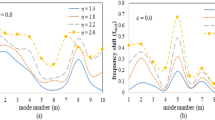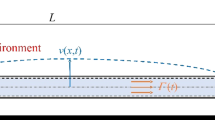Abstract—
At present, the regulatory technical documents developed in the late 21st century that stipulate design solutions and operating regulations for nuclear power plants do not include provisions for predicting and preventing the occurrence of vibroacoustic resonances of structures involving acoustic standing waves (ASWs) in operational and emergency modes and also under the effect of seismic waves. This results in that the existing feedbacks between neutronic and thermophysical processes under the conditions of coolant density fluctuations caused by ASWs have not been given proper attention. A nuclear reactor digital acoustic model (NRDAC), using which it is possible to identify the sources of self-exciting ASWs and to predict their frequency, has been developed at the NRU MPEI Department of Nuclear Power Plants. The article presents a new method for identifying the ASW frequencies in the acoustic system comprising a pressurized water reactor (in its Russian version known as a VVER, meaning a water-cooled, water moderated power-generating reactor) with the cold and hot leg pipelines connected to it. The models and analysis methods have passed verification in the Novovoronezh NPP unit 3 equipped with a VVER-440 reactor. For measuring the autospectral power densities (ASPD) of pressure pulsations, the main equipment vibration monitoring system SÜS developed by Siemens was used. The predicted values of ASW frequencies are consistent with the signals measured by pressure pulsation sensors. It is shown that the ASW frequencies depend on the operation conditions and may coincide with the pressure fluctuation frequencies caused by the operation of reactor coolant pumps (RCPs) with vibration of fuel assemblies (FAs) and equipment of the NPP reactor coolant system. It is shown that, whatever the number of coolant circulation loops, the nuclear reactor acoustic properties are similar to the properties of a group of simultaneously used Helmholtz resonators. By using the verified procedure, it is possible to optimize the design and layout solutions by constructing equipment able to minimize undesirable cyclic loads. This possibility is the most important one from the viewpoint of ensuring long-term operation of small modular reactors in maneuverable modes. Small NPPs should be highly maneuverable to complement renewable energy sources. The majority of small modular reactors are designed for little-attended operation with long periods of time between refueling outages (2–10 years vs. 12–24 months in large power units) or with the fuel loaded for the entire life cycle. The requirements of ensuring long-term operation in maneuverable modes can be fulfilled subject to minimizing the dynamic loads applied to the reactor plant structures by preventing the occurrence of hydrodynamic instability and resonances of structural vibration with acoustic fluctuations of coolant.



Similar content being viewed by others
REFERENCES
M. P. Lizorkin, Computational Modeling of Neutron-Physical and Coupled Physical-Thermohydraulic Processes in VVER Reactors, Candinate’s Dissertation in Engineering (Kurchatov Inst., Moscow, 2007).
V. Krýsl, Handbook of the Code MOBY-DICK, ŠCODA JS Report a. s. Ae10068/Dok Rev. 3 (Plzeň, 2005) [in Czech].
K. Proskuryakov, “Scientific basis for modelling and calculation of acoustic vibrations in the nuclear power plant coolant,” J. Phys.: Conf. Ser. 891, 012182 (2017). https://doi.org/10.1088/1742-6596/891/1/012182
H. F. Olson, Dynamical Analogies (Van Nostrand, New York, 1943; Gos. Izd. Inostr. Lit., Moscow, 1947).
A. A. Samarin, Vibrations of Pipelines of Power Equipment and Methods of Their Elimination (Energiya, Moscow, 1979) [in Russian].
N. V. Sharyi, Computational Substantiation Methods for Strength and Dynamics of Structures of Reactor Installations for NPP with VVER, Doctoral Dissertation in Engineering (Hydropress, Podolsk, 2008).
K. N. Proskuryakov, Thermal Hydraulic Excitation of Heat Exchanger Oscillations in Internal Devices of Nuclear Power Installations (Mosk. Energ. Inst., Moscow, 1984) [in Russian].
K. N. Proskuryakov, “Digital acoustic model of a VVER reactor,” Therm. Eng. 68 (9), 673–678 (2021).
M. T. Slepov, Development of Methods and Data Interpretation in Relation to the Systems of Noise Diagnostics of the Reactor Facilities of the Novovoronezh NPP, Candidate’s Dissertation in Engineering (I. I. Leypunsky Inst. of Physics and Power Engineering, Obninsk, 1999).
K. N. Proskuryakov, “Creation and verification of the acoustic model of a nuclear reactor,” Naukoemkie Tekhnol. 20 (4), 62–69 (2019). https://doi.org/10.18127/j19998465-201904-07
G. V. Arkadov, V. I. Pavelko, and A. I. Usanov, Vibration–Noise Diagnostics of VVER Reactors (Energoatomizdat, Moscow, 2004) [in Russian].
V. I. Pavelko, M. T. Slepov, and V. U. Khairetdinov, “Experience of carrying out comprehensive measurements using heterogeneous systems at various stages of the VVER-1200 power unit commissioning for operation,” Izv. Vyssh. Uchebn. Zaved., Yad. Energ., No. 4, 44–52 (2016).
J. Yan, K. Yuan, E. Tatl, and Z. Karoutas, “A new method to predict grid to-rod in a PWR fuel assembly inlet region,” Nucl. Eng. Des. 241, 2974–2982 (2011). https://doi.org/10.1016/j.nucengdes.2011.06.019
A. Bhattachary, S. D. Yu, and G. Kawall, “Numerical simulation of turbulent flow through a 37-element CANDU fuel bundle,” Ann. Nucl. Energy 40, 87–105 (2012). https://doi.org/10.1016/j.anucene.2011.10.017
S. Delafontain and G. Ricciardi, “Fluctuating pressure calculation induced by axial flow through mixing grid,” Nucl. Eng. Des. 242, 233–246 (2012). https://doi.org/10.1016/j.nucengdes.2011.09.033
Z. G. Liu, Y. Liu, and J. Lu, “Numerical simulation of the fluid-structure interaction for two simple fuel assemblies,” Nucl. Eng. Des. 258, 1–12 (2013). https://doi.org/10.1016/j.nucengdes.2013.01.029
A. Mohany and M. Hassan, “Modelling of fuel bundle vibration and the associated wear in a CANDU fuel channel,” Nucl. Eng. Des. 264, 214–222 (2013). https://doi.org/10.1016/j.nucengdes.2012.08.039
O. V. Mitrofanova, Hydrodynamics and Heat Transfer of Swirling Flows in Channels of Nuclear Power Facilities (Lenand, Moscow, 2020) [in Russian].
O. V. Mitrofanova, A. Sh. Bairamukov, and D. S. Urtenov, “Study of vortex formation processes in complex channels of transport nuclear power facilities,” Tepl. Protsessy Tekh. 10 (7–8), 74–282 (2018).
Author information
Authors and Affiliations
Corresponding author
Additional information
Translated by V. Filatov
Rights and permissions
About this article
Cite this article
Proskuryakov, K.N., Anikeev, A.V. & Afshar, E. Verification of a Reactor’s Digital Acoustic Model in the Startup and Nominal Operation Modes of NPPs Equipped with VVER Reactors. Therm. Eng. 68, 834–840 (2021). https://doi.org/10.1134/S0040601521100049
Received:
Revised:
Accepted:
Published:
Issue Date:
DOI: https://doi.org/10.1134/S0040601521100049




